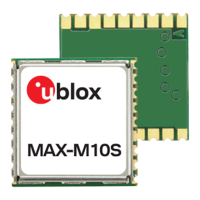MAX-M10S-Integration manual
The TIMEPULSE pin is shared with SAFEBOOT_N pin. If this pin is low at receiver startup,
the receiver enters safeboot mode. In normal operation, this pin is used for time pulse. Make
sure there is no load at this pin, which could cause the pin being low at startup.
2.3.3.4 LNA_EN
The system can turn an optional external LNA on and off using the LNA_EN signal to optimize
the power consumption. The LNA_EN signal is also used internally in MAX-M10S to control the
integrated LNA. The LNA is turned on when LNA_EN is "high". The polarity cannot be changed.
The LNA_EN signal can also be used as a part of antenna supervisor circuit to control an external
LNA or antenna power supply.
2.3.3.5 EXTINT
MAX-M10S supports external interrupts at the EXTINT pin. The EXTINT pin has a fixed input voltage
threshold with respect to V_IO. It can be used for functions such as accurate external Frequency
assistance, Time assistance and Time mark reporting.
The EXTINT pin enables External control for host-controlled on/off operation of the receiver, and as
a wake-up source for power save mode on/off operation (PSMOO). If configured for host-controlled
on/off operation, the internal pull-up is disabled. Make sure the EXTINT input is always driven within
the defined voltage level by the host.
The EXTINT pin can also be configured for another functionality.
EXTINT functionality is only available at the EXTINT pin.
2.3.3.6 TX_READY
The MAX-M10S has an internal message buffer for storing bytes to be sent to the host application.
TX-ready feature in TX_READY pin enables I2C to have associated signals to indicate that the buffer
has bytes to be transmitted. The host application can wait on the signal instead of polling the
interface. Each interface has its own indicator signal that can be assigned to any PIO/pin. Each signal
is associated to one interface and cannot be shared.
The polarity of the signal (active-low or active-high) and the threshold for amount of bytes in the
buffer can be configured with UBX-CFG-TXREADY configuration items. When the number of bytes in
the buffer reaches the threshold, the corresponding signal becomes active. The signal stays active
until all of the bytes in the buffer have been transferred. The receiver has additional small transmit
buffer for each interface. Up to 16 bytes may still need to be transferred to the host after the TX-
ready signal has become inactive.
If a PIO to be configured is invalid or already in use, the configuration for the TX_READY pin is
ignored. The rest of the interface configuration is still applied if valid. The acknowledge message
does not indicate if the TX_READY pin configuration was successfully set, it only indicates the
successful configuration of the interface. To verify the configuration of the TX_READY pin, the
interface configuration should be read back to check the setting of the TX_READY pin. The setting
is set to disabled/all zero if the configuration failed.
The threshold when TX-ready signal is activated should not be set above 2 kB. Otherwise, it is
possible that the internal message buffer gets full and some messages are discarded.
2.3.3.6.1 Extended TX timeout
If the host does not communicate over I2C for more than approximately 2 seconds, the device
assumes that the host is no longer using this interface and no more packets are scheduled for
this interface. This mechanism can be changed by enabling "extended TX timeouts", in which case
the receiver delays idling the interface until the allocated and undelivered bytes for this interface
UBX-20053088 - R03
2 Receiver functionality Page 25 of 89
C1-Public

